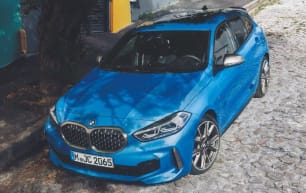The Scala might be built on a stretched Polo platform, but there is nothing short or skinny about this roomy little runabout. Long doors, wide apertures and a sense of space as a result of the six-window glass area means the Skoda squares up as a solid small hatch proposition.
Apart from the badges, umbrella holder in the driver’s door side, cruise control stalk seemingly stolen from a ‘90s Audi 80, brand-specific graphics and there being no flocked door pockets, there’s very little that isn’t VW inside. German heft, precision quality, squidgy upper plastics and a premium ambience are present in abundance.
Take the driving position. It offers a pleasing amount of adjustment so taller or larger drivers can fit inside. The same goes for the steering rack adjustment (tilt and telescopic), firm and always supportive sports-style front seats, while the weight of the switchgear and the feel of the textures are all kin to the Golf.
Drilling into them a little further, the Monte Carlo's front pews look wild. Tombstone-shaped, with outlandish shoulder flares and side bolsters, thick red striping and deep contours, they promise – and deliver – exceptional comfort and support. They're designed this way for improved body location during g-force-inducing hard cornering, speaking to this grade's athletic nature.
Both front seats offer multitude of adjustability, with lumbar support and height movement, as well as the obvious front-to-rear sliding functionality, for both front passengers. These are great chairs to travel in.
Being a Monte Carlo with Travel Pack, the (1.2-inch larger) 9.2-inch touchscreen is another expensive-looking addition, with its (fiddly and unreliable) gesture control, wide fascia, colourful look and elegant layout. It feels slick and smooth on the fingertips.
Five instrumentation panel designs are offered in the digital instrumentation, including a two-dial (speedo and tacho) approximation of an analogue dial and a full-screen map view, as well as a load of other-data related info displays. There’s bound to be one to suit everybody.
But the climate control is needlessly complicated and confusing (it takes a prod of a button in the multimedia system to access air-flow, fan speed and other controls; and what is the point of a glass roof if it doesn’t open? The fabric covering is OK but not strong enough to block out the hot sun. And how can a $40K Euro not offer digital radio nowadays?
Take away the flashy add-ons, though, and you’re still left with a basically sound cabin layout. Large door bins make up for the small-ish centre console storage (with sliding fabric-covered armrest); there’s a sizeable glovebox, two too-small cupholders (it wouldn’t hold our standard-sized Keep Cup), while vision out is very respectable – even without the big camera view.
Some surprise-and-delight details abound, but perhaps not as many as you might expect from the off-beat brand. There’s the aforementioned umbrella that lives in the driver’s door, as well as a waste-bin that sits in the driver’s door card storage area. Generous rear legroom. You’ll discover four USB-C outlets (two under the back of the centre console) and rear face-level air vents. And the Monte Carlo’s racing-car style tombstone front seats, that afford excellent forward visibility for rear-sited passengers. Our Travel Pack-derived rear (as well as front) seat warmers are also nice to behold on a cold journey.
The rear bench is pretty comfortable, though a bit more thigh support from the cushion would be appreciated. There’s no level of sliding or reclining adjustability, however, while the lack of armrest (and subsequently any form of cupholders) is a disappointing omission in any 2021 car.
Further back, behind the long and wide electrically operated tailgate is a big, deep cargo area, which stretches from 467 litres in five-seater mode to 1410 litres with the rear seatbacks dropped. Among other things, you’ll find a double-sided mat with fabric or rubber as required, sturdy bag hooks, a 12-volt boot socket, ‘Trunk Package’ with a net under the rear shelf and two hooks in the top tether), and a space-saver spare wheel beneath that low, low floor.
All-in-all, then, the Scala’s as spacious and practical as you’d expect from a Skoda.












































